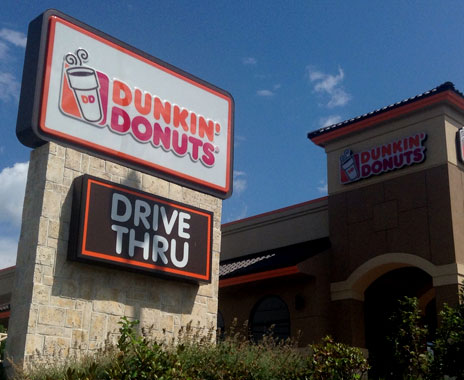Faced with stagnant same-store sales and traffic, Dunkin’ Donuts is turning to a multi-year plan to differentiate itself through convenience and simplification.
The doughnut brand posted a U.S. same-store sales increase of 0.8 percent for the second quarter of this year, driven by an average ticket increase offset by a decline in traffic. Breakfast sandwich sales increased due to Dunkin’s wake-up wraps and core sandwiches with egg and cheese.
Beverage sales were driven by the iced coffee and ice tea categories, as the brand has experienced an increase in cold brew sales and launched its fruited ice tea and frozen coffee.
But as the brand moves forward, guests can expect less new menu items and a focus on convenience and broad accessibility.
David Hoffman, president of Dunkin’ Donuts U.S. and Canada, said in a conference call the brand is beginning a multi-year plan to “transform Dunkin’ into a beverage-led, on-the-go brand.”
Dunkin’ will simplify menus across system restaurants, removing items such as afternoon sandwich selections and bakery items like danish and cookies, in an effort to reduce operational complexities at locations. Hoffman said the brand believes this simplification can reduce labor turnover and allow operators and employees to focus on the basics of customer service. The streamlined menu will roll out to restaurants in two waves beginning in August, with a goal to reach 1,000 locations through October.
“Simplification will continue to be a cultural mindset for our system,” Hoffman said.
The brand will also focus on ways to offer customers “unparalleled convenience,” through initiatives like curbside delivery and mobile ordering, third-party delivery, and an increase in drive-thrus.
Hoffman said that 85 percent of traditional store openings will contain a drive-thru alongside new store designs, compared with 70 percent of store openings five years ago. Fifty five percent of all Dunkin’ Donuts locations have a drive-thru.
“Our goal is to be agnostic as to how our guests use Dunkin,” Hoffman said. “[They can] order how they want, pay how they want, and get their beverages and food how they want.”
“Wrap all of this with modern brand expression— including new restaurant design—and we’re confident this plan will put our system on the next wave of long-term sustainable growth,” Hoffman said.
In the second quarter, Baskin-Robbins U.S. comparable store sales fell by 0.9 percent, driven by a decline in traffic offset by increased average ticket. Sales of cups and cones, desserts, and beverages decreased during the second quarter, offset by increases in take home sales. Revenues for parent company Dunkin’ Brands increased 1 percent due to royalty income from systemwide sales growth and increases in rental income due to more leases for franchised locations.









